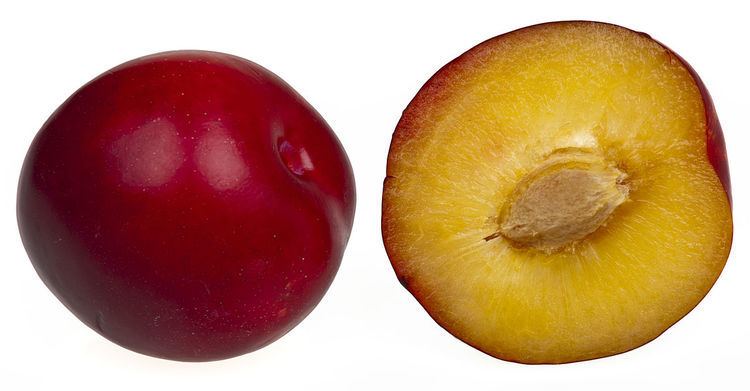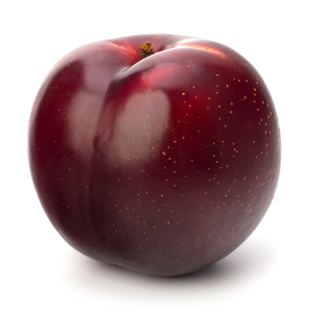Kingdom Plantae Family Rosaceae Genus Prunus Potassium 157 mg (per 100 g) Vitamin c 9.5 mg (per 100 g) Calcium 6 mg (per 100 g) | Order Rosales Subfamily Amygdaloideae Subgenus Prunus Protein 700 mg (per 100 g) Iron 170 mcg (per 100 g) | |
 | ||
Energy 45.89 Calories (per 100 g) Similar Peach, Apricot, Prune, Pear, Cherry | ||
How to grow a plum tree from seed
A plum is a fruit of the subgenus Prunus of the genus Prunus. The subgenus is distinguished from other subgenera (peaches, cherries, bird cherries, etc.) in the shoots having terminal bud and solitary side buds (not clustered), the flowers in groups of one to five together on short stems, and the fruit having a groove running down one side and a smooth stone (or pit).
Contents
- How to grow a plum tree from seed
- Easy way to grow plum trees out of seed also works with peaches nectarines and apricots
- Description
- Species
- Cultivation and uses
- History
- Etymology and names
- Production
- References

Mature plum fruit may have a dusty-white waxy coating that gives them a glaucous appearance. This is an epicuticular wax coating and is known as "wax bloom". Dried plum fruits are called dried plums or prunes, although, in American English, prunes are a distinct type of plum, and may have pre-dated the fruits now commonly known as plums.

Easy way to grow plum trees out of seed also works with peaches nectarines and apricots
Description
Plums are a diverse group of species. The commercially important plum trees are medium-sized, usually pruned to 5–6 metres height. The tree is of medium hardiness. Without pruning, the trees can reach 12 metres in height and spread across 10 metres. They blossom in different months in different parts of the world; for example, in about January in Taiwan and early April in the United Kingdom.

Fruits are usually of medium size, between 1 and 3 inches in diameter, globose to oval. The flesh is firm and juicy. The fruit's peel is smooth, with a natural waxy surface that adheres to the flesh. The plum is a drupe, meaning its fleshy fruit surrounds a single hard seed.
Species
Plum has many species, and taxonomists differ on the count. Depending on the taxonomist, between 19 and 40 species of plum exist. From this diversity only two species, the hexaploid European plum (Prunus domestica) and the diploid Japanese plum (Prunus salicina and hybrids), are of worldwide commercial significance. The origin of these commercially important species is uncertain but may have involved P. cerasifera and possibly P. spinosa as ancestors. Other species of plum variously originated in Europe, Asia and America.
The subgenus Prunus is divided into three sections:
Cultivation and uses
The taste of the plum fruit ranges from sweet to tart; the skin itself may be particularly tart. It is juicy and can be eaten fresh or used in jam-making or other recipes. Plum juice can be fermented into plum wine. In central England, a cider-like alcoholic beverage known as plum jerkum is made from plums.
Dried plums (or prunes) are also sweet and juicy and contain several antioxidants. Plums and prunes are known for their laxative effect. This effect has been attributed to various compounds present in the fruits, such as dietary fiber, sorbitol, and isatin. Prunes and prune juice are often used to help regulate the functioning of the digestive system. Dried prune marketers in the US have, in recent years, begun marketing their product as "dried plums". This is due to "prune" having negative connotations connected with elderly people suffering from constipation.
Dried, salted plums are used as a snack, sometimes known as saladito or salao. Various flavors of dried plum are available at Chinese grocers and specialty stores worldwide. They tend to be much drier than the standard prune. Cream, ginseng, spicy, and salty are among the common varieties. Licorice is generally used to intensify the flavor of these plums and is used to make salty plum drinks and toppings for shaved ice or baobing.
Pickled plums are another type of preserve available in Asia and international specialty stores. The Japanese variety, called umeboshi, is often used for rice balls, called onigiri or omusubi. The ume, from which umeboshi are made, is more closely related, however, to the apricot than to the plum.
As with many other members of the rose family, plum seeds contain cyanogenic glycosides, including amygdalin. These substances are capable of decomposing into a sugar molecule and hydrogen cyanide gas. While plum seeds are not the most toxic within the rose family (the bitter almond is the most toxic), large doses of these chemicals from any source are hazardous to human health. On the other hand, plums are considered a source of phytochemical compounds with beneficial effects on health.
Prune kernel oil is made from the fleshy inner part of the pit of the plum.
Plums come in a wide variety of colours and sizes. Some are much firmer-fleshed than others, and some have yellow, white, green or red flesh, with equally varying skin colour.
Though not available commercially, the wood of plum trees is used by hobbyists and other private woodworkers for musical instruments, knife handles, inlays, and similar small projects.
Plum cultivars in use today include:
When it flowers in the early spring, a plum tree will be covered in blossoms, and in a good year approximately 50% of the flowers will be pollinated and become plums. Flowering starts after 80 growing degree days.
If the weather is too dry, the plums will not develop past a certain stage, but will fall from the tree while still tiny, green buds, and if it is unseasonably wet or if the plums are not harvested as soon as they are ripe, the fruit may develop a fungal condition called brown rot. Brown rot is not toxic, and very small affected areas can be cut out of the fruit, but unless the rot is caught immediately, the fruit will no longer be edible. Plum is used as a food plant by the larvae of some Lepidoptera, including November moth, willow beauty and short-cloaked moth.
The Serbian plum (Serbian: шљива / šljiva) is the third most produced in the world. In the Balkans, plum is converted into an alcoholic drink named slivovitz (plum brandy) (Serbian: шљивовица / šljivovica).
A large number of plums, of the Damson variety, are also grown in Hungary, where they are called szilva and are used to make lekvar (a plum paste jam), palinka (traditional fruit brandy), plum dumplings, and other foods. The region of Szabolcs-Szatmár, in the northeastern part of the country near the borders with Ukraine and Romania, is a major producer of plums.
The plum blossom or meihua (Chinese: 梅花; pinyin: méihuā), along with the peony, are considered traditional floral emblems of China.
The plum is commonly used in China, Yunnan area, to produce a local plum wine with a smooth, sweet, fruity taste and approximately 12% alcohol by volume.)
History
Plums may have been one of the first fruits domesticated by humans. Three of the most abundant cultivars are not found in the wild, only around human settlements: Prunus domestica has been traced to East European and Caucasian mountains, while Prunus salicina and Prunus simonii originated in Asia. Plum remains have been found in Neolithic age archaeological sites along with olives, grapes and figs.
Etymology and names
The fruit Prunus armeniaca gained its name from the beliefs of Pliny the Elder, a Roman historian and scientist of the first century, who maintained the apricot was a kind of a plum, and had originally come from Armenia. Armenian sources support their claims by referring to a 6,000-year-old apricot pit found in an archaeological site near Yerevan. Other historians point to Mesopotamia as a clue to the Latin name. Apricots were cultivated in Mesopotamia, and it was known as armanu in the Akkadian language, but this did not refer to Armenia as that is not the name by which that geographic region was known in the Akkadian language. It is likely that Pliny's explanation is a folk etymology based on the similarity between the Mesopotamian name for the fruit and the Latin name for Armenia.
In certain parts of the world, some fruits are called plums and are quite different from fruits known as plums in Europe or the Americas. For example, marian plums are popular in Thailand, Malaysia and Indonesia, otherwise also known as gandaria, plum mango, ma-praang, ma-yong, ramania, kundang, rembunia or setar. Another example is the Chinese Plum, popular as pipa or Chinese plums in East Asia and Southeast Asia, and as Japanese medlar, loquat, nispero, bibassier and wollmispel elsewhere. In South Asia and Southeast Asia, Jambul - a fruit from tropical tree in Myrtaceae family, is similarly sometimes referred to 'damson plums', and it is different from damson plums found in Europe and Americas. Jambul is also called as Java plum, Malabar plum, jaman, jamun, jamblang, jiwat, salam, duhat, koeli, jambuláo or koriang.
Production
Plums are produced around the world, and China is the world's largest producer. The table above shows the ten largest producers of plums and sloe in 2013; the second to tenth rankings change almost every year due in part to the alternate bearing nature of plum trees.
In the United States, the Japanese varieties of plums are predominant. California was the dominant producer in 2011; other producers are Oregon, Washington, Idaho and Michigan. Mild winters, minimal rainfall during the growing season and low humidity favor more productive crops in California.
